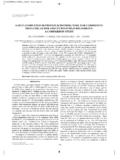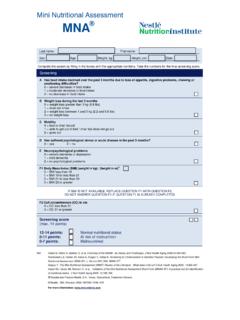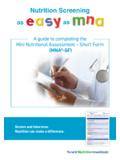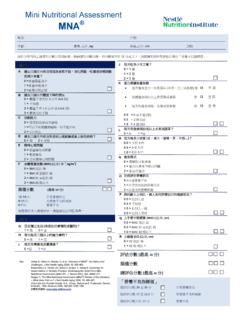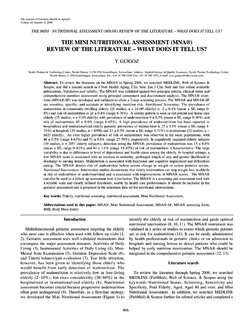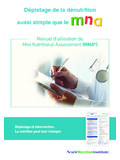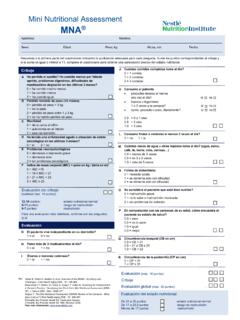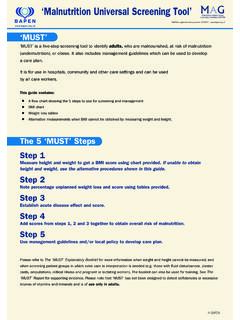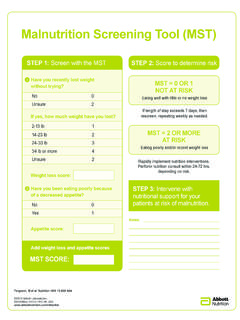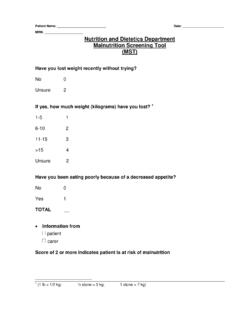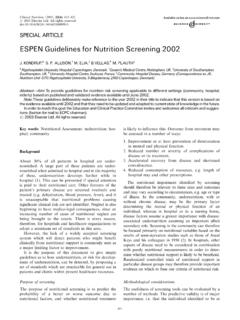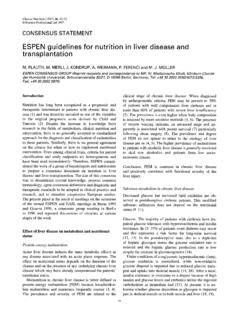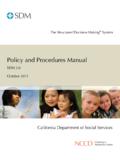Transcription of Nutrition Screening - MNA® Elderly - Overview
1 A guide to completing the Mini Nutritional Assessment Short Form (MNA -SF) Print CMYK | Blue = C 100% / M 72% / B 18% | Green = C 80% / Y 90% Screen and intervene. Nutrition can make a Screeningasas2 IntroductionMini Nutritional Assessment Short Form (MNA -SF)The MNA -SF is a Screening tool to help identify Elderly patients who are malnourished or at risk of malnutrition. This User Guide will assist you in completing the MNA -SF accurately and consistently. It explains each question and how to assign and interpret the the prevalence of malnutrition in the free living Elderly population is relatively low, the risk of malnutrition increases dramatically in the institutionalized and hospitalized The prevalence of malnutrition is even higher in cognitively impaired Elderly individuals and is associated with cognitive who are malnourished when admitted to the hospital tend to have longer hospital stays, experience more complications.
2 And have greater risks of morbidity and mortality than those whose nutritional state is identifying older persons who are malnourished or at risk of malnutrition either in the hospital or community setting, the MNA -SF allows clinicians to intervene earlier to provide adequate nutritional support, prevent further deterioration, and improve patient Nutritional Assessment Short Form (MNA -SF)The MNA -SF provides a simple and quick method of identifying Elderly persons who are at risk for malnutrition, or who are already malnourished. It identifies the risk of malnutrition before severe changes in weight or serum protein levels MNA -SF was developed by Nestl and leading international geriatricians and remains one of the few validated Screening tools for the Elderly .
3 It has been well validated in international studies in a variety of settings5-7 and correlates with morbidity and 2009 the MNA -SF was validated as a stand alone Screening tool , based on the full MNA .8 The MNA -SF may be completed at regular intervals in the community and in the hospital or long-term care setting. It is recommended to be done annually in the community, and every 3 months in the hospital or long-term care or whenever a change in clinical condition to complete the MNA -SFBefore beginning the MNA -SF, please enter the patient s information on the top of the form: Name Gender Age Weight (kg) To obtain an accurate weight, remove shoes and heavy outer clothing.
4 Use a calibrated and reliable set of scales. Pounds (lbs) must be converted to kilograms (1 lb = kg). Height (cm) Measure height without shoes using a stadiometer (height gauge). If the patient is bedridden, measure height by demispan, half arm-span, or knee height (see Appendix 2). Inches must be converted to centimeters (1 inch = cm). Date of screenScreen and intervene. Nutrition can make a Mini Nutritional Assessment Short Form (MNA -SF) is an effective tool to help identify patients who are malnourished or at risk of malnutrition 4 Most validated tool for the Elderly - Sensitive and reliable - Recommended by national and international organisations - Supported by more than 450 published studies4 Quick and easy to use - Screen in less than 5 minutes - Requires no special training - No laboratory data needed4 Effective - Identifies at-risk persons before weight loss occurs4 Facilitates early interventionInterveneRecommend Nestl Nutrition supplements to help your patients improve their nutritional statusMonitor4 Inexpensive diagnostic tool - The MNA -SF
5 tool allows standardised, reproducible and reliable determination of nutritional status - Use the MNA -SF regularly to assess your patients nutritional status and provide intervention as required4 Screening (MNA -SF)Complete the screen by filling in the boxes with the appropriate numbers. Total the numbers for the final Screening PointsAsk the patient to answer questions A F, using the suggestions in the shaded areas. If the patient is unable to answer the question, ask the patient s caregiver to answer or check the medical record. AHas food intake declined over the past three months due to loss of appetite, digestive problems, chewing or swallowing difficulties?
6 Score 0 = Severe decrease in food intake 1 = Moderate decrease in food intake 2 = No decrease in food intakeAsk patient or caregiver or check the medical record Have you eaten less than normal over the past three months? If so, is this because of lack of appetite, chewing, or swallowing difficulties? If yes, have you eaten much less than before or only a little less? BInvoluntary weight loss during the last 3 months?Score 0 = Weight loss greater than 3 kg ( pounds) 1 = Does not know 2 = Weight loss between 1 and 3 kg ( and pounds) 3 = No weight lossAsk patient / Review medical record Have you lost any weight without trying over the last 3 months?
7 Has your waistband gotten looser? How much weight do you think you have lost? More or less than 3 kg (or 6 pounds)? Though weight loss in the overweight Elderly may be appropriate, it may also be due to malnutrition. When the weight loss question is removed, the MNA loses its sensitivity, so it is important to ask about weight loss even in the and intervene. Nutrition can make a the patient suffered psychological stress or acute disease in the past three months?Score 0 = Yes 2 = NoAsk patient / Review patient medical record / Use professional judgment Have you been stressed recently? Have you been severely ill recently? CMobility?
8 Score 0 = Bed or chair bound 1 = Able to get out of bed/chair, but does not go out 2 = Goes outAsk patient / Review patient s medical record / Ask caregiver How would you describe your current mobility? Are you able to get out of a bed, a chair, or a wheelchair without the assistance of another person? if not, would score 0 Are you able to get out of a bed or a chair, but unable to go out of your home? if yes, would score 1 Are you able to leave your home? if yes, would score 2 ENeuropsychological problems?Score 0 = Severe dementia or depression 1 = Mild dementia 2 = No psychological problemsReview patient medical record / Use professional judgment / Ask patient, nursing staff or caregiver Do you have dementia?
9 Have you had prolonged or severe sadness? The patient s caregiver, nursing staff or medical record can provide information about the severity of the patient s neuropsychological problems (dementia).6F1 Body mass index (BMI)? (weight in kg / height in m2)Score 0 = BMI less than 19 1 = BMI 19 to less than 21 2 = BMI 21 to less than 23 3 = BMI 23 or greaterDetermining BMIBMI is used as an indicator of appropriate weight for height (Appendix 1)BMI Formula US units BMI = ( Weight in Pounds / [Height in inches x Height in inches] ) x 703 BMI Formula Metric units BMI = ( Weight in Kilograms / [Height in Meters x Height in Meters] ) 1 Pound = Kilograms 1 Inch = CentimetersBefore determining BMI, record the patient's weight and height on the MNA If height has not been measured, please measure using a stadiometer or height gauge (Refer to Appendix 2).
10 2. If the patient is unable to stand, measure height using indirect methods such as measuring demi-span, arm span, or knee height. (See Appendix 2). 3. Using the BMI chart provided (Appendix 1), locate the patient s height and weight and determine the BMI. 4. Fill in the appropriate box on the MNA form to represent the BMI of the To determine BMI for a patient with an amputation, see Appendix BMI IS NOT AVAILABLE, REPLACE QUESTION F1 WITH QUESTION F2. DO NOT ANSWER QUESTION F2 IF QUESTION F1 IS ALREADY COMPLETED. Screen and intervene. Nutrition can make a Answer only if unable to obtain circumference (CC) in cm0 = CC less than 313 = CC 31 or greater Measuring Calf Circumference1.
